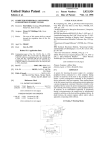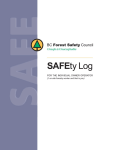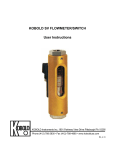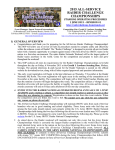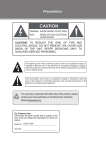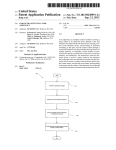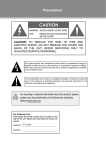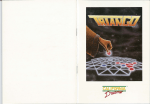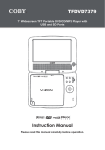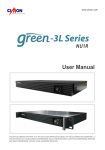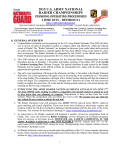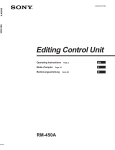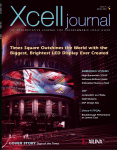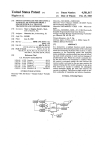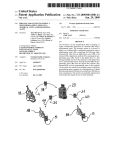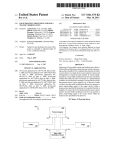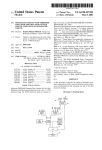Download Remote control system
Transcript
United States Patent [19] 4,430,652 [11] [45] Rothenbuhler et al. [54] REMOTE CONTROL SYSTEM [56] Feb. 7, 1984 References Cited U.S. PATENT DOCUMENTS [75] Invent0r8= Dan _E- Rothenbuhler, Acme; Galen A-B1ery,Jr-, Belllngham, both of 4,038,590 7/1977 Knowlton .................... .. 340/825.69 4,178,549 12/1979 Ledenbach et al. 340/825.69 Wash. 4,197,525 4/1980 Biery et al. ................... .. 340/825.65 Primary Examiner-—Donnie L. Crosland [73] Assignee: Rothenbuhler Engineering Co., Attorney, Agent, or Firm——Christensen, O’Connor, Sedro-Woolley, Wash. Johnson & Kindness [57] ABSTRACT A remote control system capable of utilizing manually encoded signals is disclosed. The system is particularly [21] APPI- N04 325,016 . _ suitable for use in the logging industry because it is [22] Flled' Nov' 25’ 1981 capable of utilizing standardized whistle signals for both remove control and audible signalling purposes. The [51] Int. Cl.3 ............................................ .. G08C 19/00 System includes a transmitter for transmitting a manu [52] U.S. Cl. ........................ .. IMO/825.69; 340/825.72; ally encoded signal. The control signal is received by a 340/825.57; 340/82564; 340/870_21; receiver and is decoded by a decoder that reduces the 34()/870.24; 375/23; 375/95; 212/160 manually encoded signal to a digitized signal. The digi [5 8] Field of Search .................... .. 340/ 825.69, 825.72, tiled signal is compared with a set of reference digitized 340/ 825.6, 825.63, 825.64, 825.65, 825.57, 825.58, 82575, 539, 870,19, 870,24, 870,23, signals, and if a match is found, a corresponding output control signal is applied to a controlled device such as a 870.21, 870.2, 870.22; 375/23, 22, 25, 69, 75, 95, 96, 94; 370/8-9; 455/38, 70, 603; 212/160; 214/DIG. 2 //z 5/6/4444 WWW /0 / v W/VIII/f/Z? ‘ ‘V yarder. ' 20 Claims, 11 Drawing Figures A; f [Eff/V56 a 20 / Z4 Z0 f A,1 MTV/$4M 02700512 ‘ X 95W! 9 Adi/£2! 26 f/i/t/lll/t/é w/o/ ?éV/[E j 22 ‘v (m[1!p MM; / 2‘ US. Patent Feb. 7, 1984 257/12” 70 b’fé/A/ Ma 54) Sheet 5 of7 4,430,652 1 4,430,652 2 of a remote control system having a coding scheme REMOTE CONTROL SYSTEM based on manually generated whistle signals. Accordingly, it is an object and purpose of the pres ent invention to provide an apparatus for utilizing man The present invention is generally related to remote 5 ually encoded signals in a remote control system. More speci?cally, it is an object of the invention to provide an control systems and, more particularly, to remote con FIELD OF‘THE INVENTION trol systems that utilize manually encoded signals which are decoded to provide corresponding output control apparatus for utilizing manually encoded whistle signals in a remote control system for use in the logging indus signals and to execute predetermined control functions. try. It is also an object to achieve the foregoing objects in BACKGROUND OF THE INVENTION The logging industry is one area in which the use of a remote control system wherein signals are manually manually encoded signals has evolved extensively. Such signals are known in the trade as whistle signals and are employed as a means of communication be tween workers in the ?eld. As the name implies, the encoded according to a predetermined coding scheme, and wherein such signals are decoded to execute prede termined control functions. It is another object of the invention to provide a remote control system wherein manually encoded sig signals consist of predetermined sequences of long and nals are decoded to execute predetermined control short whistle blasts produced by a whistle, horn, or other audible signalling device. Typically, the audible are also utilized to produce audible signals that repre signalling device is remotely actuated by radio-fre quency (RF) signals from a manually actuated transmit ter held by a worker. Each signal represents a speci?c instruction from one worker to another and usually pertains to the operation of a speci?c type of machin ery. For example, standardized whistle signals are used to indicate a desired operation of yarding lines and associated yarders used in yarding operations. In addition to communicating instructions from one worker to another, whistle signals serve an important safety function in alerting other workers in the vicinity of immediately impending changes in the operation of the machinery. In this regard, workers in the logging industry are cognizant of the standardized whistle sig nals and rely on such signals for forewarning of changes in the operation of the machinery. In recognition of this safety aspect of the use of whistle signals, various states and regulatory agencies have promulgated laws and regulations mandating the use of standardized whistle signals in logging operations. In recent years the advantages of remote control functions, and wherein the manually encoded signals sent and serve to announce the control functions being executed. These and other objects will be apparent on consider ation of the ensuing description of the invention and the accompanying drawings. SUMMARY OF THE INVENTION In accordance with the present invention, a remote control system includes a transmitting means for trans ~mitting a manually encoded signal consisting of a se quence of pulses and interpulse spaces, a receiving means for receiving the signal, and a decoding means for decoding the received signal and applying a corre sponding output control signal to a controlled device. The decoding means includes ?rst means for measuring the durations of the pulses as well as the durations of the interpulse spaces. The decoding means further includes second means for digitizing the pulse and space dura tions by comparing the durations of successive pulses and discriminating between long and short pulses and by likewise comparing the durations of successive spaces and discriminating between long and short spaces, to thereby produce a digital representation of the manually encoded signal. Finally, the decoding systems, usually radio control systems, have become apparent in the logging industry. The advent of such systems has been complicated, however, by the neces means includes a third means for correlating the digital sity of adhering to the use of manually generated, stan 45 representation with a plurality of reference digital rep dardized whistle signals for indicating the desired oper resentations each corresponding to one of a plurality of ations of logging machinery. Although there are vari predetermined output control signals and for selecting ous well known types of remote control systems that could be adapted to provide remote control of logging equipment, there has not been previously available a one of the output control signals upon determination of a match between the digital representation and one of the reference digital representations, and fourth means remote control system having a coding scheme based on standard whistle signals. In large part this is due to the fact that the whistle signals are manually generated and controlled device. In a preferred embodiment of the invention, the ?rst are thus subject to some variation from one worker to means, second means and third means are incorporated for supplying the selected output control signal to the another, as well as variation in a given signal when 55 in a digital computer that executes the timing, digitizing produced at different times by an individual worker. and correlating functions in accordance with a prede For example, there may be signi?cant variation in dura termined computer program. In such an embodiment, tion of the individual whistle blasts making up the sig the digital representation includes one or more digital nal, as well as variation in the durations of the interven words and each reference digital representation in ing pauses, or spaces, between whistle blasts. Also, 60 cludes one or more corresponding reference digital there may be a signi?cant variation in the relative . words. If a match is found between the word or words lengths of long and short whistle blasts, as well as varia in the digital representation and the word or words in a reference digital representation, the decoding means tions in the relative durations of the intervening long selects the corresponding output control signal and and short spaces. Although such variation does not ordinarily pose any problem with respect to communi 65 supplies that signal to the controlled device. In accordance with another aspect of the invention, cation and understanding between workers in the ?eld, who compensate for such variation as a matter of pulses are determined to be either long or short by course, it has heretofore prevented the implementation comparing the duration of each pulse with the average 4,430,652 3 duration of the longest and shortest pulses, and spaces are likewise determined to be either long or short by comparing the duration of each space with the average duration of the longest and shortest spaces. In another aspect of the invention, all of the pulses are ?rst compared to determine if the duration of the lon gest pulse is greater than the'duration of the shortest 4,197,525, issued Apr. 8, 1980, to Biery et al., both of which are assigned to the assignee of the present inven tion and both of which are hereby incorporated by reference. , The audible signalling device 16 produces an audible “whistle” signal that corresponds to the manually en coded signal. Ordinarily, the receiver 14 and the de coder 18, and possibly also the signalling device 16, are pulse by more than a predetermined amount, for exam ple, by a factor of two. If the longest pulse is not greater than the shortest pulse by more than such an amount, it is assumed that all pulses are short pulses and the system incorporated in a single receiving unit, although they decodes the signal accordingly. If the longest pulse is longer than the shortest pulse by more than the prede termined amount, then the longest and shortest pulse are illustrated separately for the purpose of this descrip tion. The decoder 18 decodes the received, manually encoded signal and applies a predetermined output con durations are averaged and the pulses are evaluated as being either long or short, as noted above. This proce dure effectively takes into account the substantial differ ence in average pulse lengths commonly observed in manually encoded signals consisting of a sequence of like pulses. 4 as disclosed in US. Pat. No. Re. 27,044, reissued Feb. 2, 1971 to Rothenbuhler et al. and in US. Pat. No. trol signal 20 to a controlled device 22 through an inter face device 24. Controlled device 22 may consist of any one of various types of machinery that may be advanta geously remoted controlled, for example, a yarding line assembly. In FIG. 1, the output control signal 20 is 20 represented by a wide arrow to indicate that there are These and other aspects and advantages of the inven multiple connections between the decoder 18 and the controlled device 22 through the interface device 24, with the decoder 18 actuating various functions of the tion will become more apparent on consideration of the following detailed description of a preferred embodi ment and the accompanying ?gures. BRIEF DESCRIPTION OF THE DRAWINGS FIG. 1 is a schematic block diagram of a preferred embodiment of the remote control system of the present controlled device 22 depending on the particular en 25 coded signal received. A second wide arrow 26 repre sents a set of feedback connections between the con trolled device 22 and the decoder 18 through the inter face device 24, which feedback connections provide signals to the decoder that positively indicate the states of the various functions under remote control. The signalling switch 12 may be a simple spring invention including a decoder; FIG. 2 is a schematic illustration of an exemplary manually encoded signal; FIG. 3 is a block diagram of the decoder; FIG. 4 is a simpli?ed flow chart illustrating the se biased ON/OFF switch that is selectively opened and closed so as to cause the transmitter 10 to produce a quential operation of the remote control system while manually encoded signal such as that represented sche under computer program control; 35 matically in FIG. 2. Such a signal consists of a sequence FIGS. 5A-5B are a more detailed ?ow chart of the of pulses 30 that are separated by intervening spaces 32. operation of the decoder under main program control; For a time corresponding to the duration of each pulse, FIGS. 6A-6B are a ?ow chart illustrating the opera tion of the decoder while under control of a REDUCE resenting the duration of successive pulses and spaces in the audible signalling device 16 is actuated to produce a whistle blast, and for a time corresponding to the dura tion of each space, the audible signalling device 16 is deactuated and therefore silent. The durations of both the pulses 30 and spaces 32 are variable. In accordance with the standard system of whistle signals used in the the manually encoded signal; logging industry, the pulses 30 are either short or long subroutine; FIG. 7 is a schematic representation of memory loca tions in the decoder used for storage of count data rep FIG. 8 is a schematic representation of REF 1 and 45 in duration, and the spaces 32 are likewise either short REF 2 memory locations in the decoder and a NUM or long. The long spaces correspond generally to pauses BER register in the decoder which contain a digital between groups of pulses, whereas the short spaces representation of the manually encoded signal in FIG. generally correspond to the spacing between pulses in each pulse group. Termination of the whistle signal is FIG. 9 is a schematic representation of a table in 50 signi?ed by an excessively long space 33 (whose dura memory in the decoder which contains a plurality of tion is greater than that of any of the interpulse spaces reference digital representations'each corresponding to 32) following any of pulses 30. 2; and, ' a predetermined output control signal from the remote control system. DETAILED DESCRIPTION OF THE PREFERRED EMBODIMENT Referring to FIG. 1, a preferred embodiment of the remote control system includes a transmitter 10 that is The durations of both the pulses 30 and the spaces 32 are ordinarily somewhat variable due to the fact that 55 actuated by a signalling switch 12 so as to emit a manu 60 ally encoded signal 13 modulated in an appropriate they are manually generated and thus subject to human variation in their timing. The decoding of such a signal, notwithstanding the variability in pulse and space dura tions, is accomplished by the decoder in a manner de scribed more fully below. In the preferred embodiment, the decoder 18 includes a suitably programmed digital computer such as the manner on a RF carrier. Signal 13 is received by a eight-bit, single-chip microcomputer sold by Intel Cor receiver 14 that demodulates the manually encoded signal and applies it to both an audible signalling device poration of Santa Clara, Calif. and identi?ed by the Model No. 8748. Details regarding the operation and 16 and to a decoder 18. Preferably, the transmitter and tion and demodulation of the manually encoded signal programming of the 8748 microcomputer are set forth in a user’s manual published by Intel Corporation in 1978 under the title “MCS-48 Microcomputer User’s by means of a scheme known as “two-tone sequential” Manual”. With reference now to FIG. 3, the decoder of the receiver are constructed so as to provide modula 5 4,430,652 6 crocomputer that consist of a clock, a CPU, a program memory, a data memory, a timer/event counter, and a that corresponds to an unacceptably long whistle blast duration, ordinarily approximately one second. If the count is too large, then it is determined that the pulse is plurality of I/O ports. The clock provides appropriate too long and represents an aberrant signal and a return the preferred embodiment includes a single-chip mi is made to the start of the main program. If the count in clock signals to the CPU, and the CPU, the program the COUNTER register is not too large and the pulse is memory, the data memory, the timer/event counter, and the I/O ports are interconnected by appropriate still present (as detected in step 107), the microcom puter returns to the DELAY subroutine and continues data and address buses and appropriate control lines. A incrementing the count in the COUNTER register at set of program instructions required for the operation of the decoder is stored in the program memory (and de 10 2.5 millisecond intervals. Upon termination of the pulse as detected in step 107, cribed hereinafter with reference to FIGS. 4, 5A, 5B, a determination is made in step 108 as to whether the 6A and 6B) and all data storage and computations are carried out in the data memory (with a portion of the data memory being described hereinafter with refer ence to FIGS. 7, 8 and 9). The manually encoded signal count in the COUNTER register is too small. If the count is too small, for example, less than a predeter through the I/O ports, as are the signals on feedback mined minimum count corresponding to approximately 50 milliseconds, the pulse is ignored and the microcom puter returns to step 103 wherein the COUNTER regis connections 26 from the controlled device 22 through ter is reset to zero. This step of the program effectively from receiver 14 is provided to the microcomputer interface device 24. The I/O ports are also connected to prevents spurious momentary pulses from being consid a plurality of control relays 34 by interconnections 36, ered as valid pulses. Upon termination of the ?rst pulse and after af?rma tive determination that the duration of the pulse as de termined by the count in the COUNTER register is put control signal 20 (in the form of relay contact clo neither too long nor too short, the count in the sures) to the controlled device 22 through interface 25 COUNTER register (step 109) is stored in a memory device 24. and the signals on interconnections 36 cause control relays 34 to assume various states so as to provide out FIG. 4 is a simpli?ed flow chart illustrating the oper ation of the decoder 18 under program control. Upon start-up of the decoder, the microcomputer places all location indicated by the current value of the POINTER register, which in the ?rst instance is a ?rst memory location set aside for recording of count data. -A schematic representation of how the memory loca control relays 34 in a desired initial state. The mi crocomputer then waits for a signal from receiver 14. 30 tions for count data are con?gured and sequentially loaded is shown in FIG. 7. Upon receipt of a signal, the durations of the pulses 30 The POINTER and NUMBER registers are also and the intervening spaces 32 are successively mea‘ incremented in step 109. In the ?rst instance, the sured. Upon detection of the end of a whistle signal, the POINTER register thus will point to a second memory measured durations of the pulses and spaces are digi tized into short and long pulses and spaces, and corre 35 location for count data and the NUMBER register thus sponding digital words are assembled. The digital words are compared with entries in a look-up table in the data memory until a match is found. Upon ?nding a match, the microcomputer executes corresponding in will contain a count of one. In the next step 110, a deter mination is made as to whether the count in the NUM BER vregister is too large by comparing the count with a predetermined maximum count. As can be appreci structions on the basis of an address located in the look 40 ated, the count in the NUMBER register represents the up table by causing control relays 34 to assume those number of pulses thus far received in the whistle signal. states representing the output control signal required for the Whistle signal. If the maximum number of whistle blasts in any stan dardized whistle signal is eight, the predetermined max imum count is eight. A more detailed flow chart is set forth in FIGS. Provided the count in the NUMBER register is not 5A-5B and 6A-6B. Brie?y, FIGS. 5A-5B illustrate the 45 too large, the COUNTER register is reset to zero in operation of the decoder under main program control, step 111, and the duration of the ensuing space is mea whereas FIGS. 6A-6B illustrate the operation of the sured in steps 112, 113 and 114. In this regard, the decoder under control of a major subroutine entitled REDUCE. Referring to FIG. 5A, upon start-up of the DELAY subroutine is again implemented in step 112. decoder a STOP signal is generated in step 101 so as to cause each of the control relays 34 to be placed in a desired initial state. The microcomputer then enters a As with the pulses, there is a limit set on the maximum In the next step 104, the presence or absence of an en large and a pulse is absent, the microcomputer contin coded signal is detected, as indicated by receipt of a pulse from the receiver 14. If a pulse is detected, the ues to pass through the DELAY subroutine to incre ment the count in the COUNTER register at 2.5 milli microcomputer enters a subroutine denoted DELAY second intervals. Upon the detection of a pulse in step (step 105), in which the count in the COUNTER regis 114, a determination is made in step 115 so as to whether permissible duration of a valid space, for example, one second. If the count in the COUNTER register exceeds a predetermined maximum count corresponding to this routine identi?ed as BEGIN. In step 102, a register maximum permissible duration, a determination is made dedicated for use as a pointer, which is hereinafter re ferred to as the POINTER register, is set to a predeter 55 in step 113 that the whistle signal has ended and the microcomputer proceeds directly to the routines shown mined initial value. Also, a second dedicated register, in FIG. 5B. If the count is not too large, a determination referred to hereinafter as the NUMBER register, is is made in step 114 as to whether a pulse is present. As reset to zero. In the next step 103, a register referred to long as the count in the COUNTER register is not too hereinafter as the COUNTER register is reset to zero. ter is incremented by one after the elapse of 2.5 millisec 65 the count in the COUNTER register is too small. This determination effectively prevents the registering of onds. After each increment, a determination is made in spurious momentary gaps in a pulse as valid spaces. If step 106 as to whether the count in the COUNTER such a spurious gap (usually less than 50 milliseconds) is register is greater than a predetermined maximum count 7 4,430,652 detected, i.e., if the countin the COUNTER register is less than a predetermined minimum count correspond ing to the spurious gap, the POINTER register is decre mented (step 117) and the count in the thus-pointed 8 the determination in step 122 will always be negative since there always will be at least one pulse in each whistle signal. Then, an accumulator is reset to zero the previous pulse) is stored in the COUNTER register. (step 123) and an LRG routine is entered in which the duration of the longest pulse is determined. This is done by sequentially comparing the pulse counts stored in the The function of this step in the program is to restart the memory locations with the current count in the accu timing of the previous pulse at the previous count there for as the microcomputer returns to step 105. Assuming that the count in the COUNTER register is not too small, i.e., that a valid interpulse space has been detected and timed, the count in the COUNTER register is stored (step 116) at the memory location indicated by the POINTER register, which for the ?rst than the count in the accumulator, the determination in step 124 is negative so that the memory address in the POINTER register is stored in a register identi?ed as R1 (step 125). Then the pulse count from the memory memory location for count data (which is the count for space is the second memory location for count data. The POINTER register is then incremented and the microcomputer returns to step 103 to begin timing the next pulse. It will be seen from the discussion thus far that as the microcomputer continues to loop through that portion of the BEGIN routine starting at step 103, the durations of successive pulses and interpulse spaces mulator. More speci?cally, if a pulse count is not less location pointed to by the pointer (i.e., pointed to by the address in R1) is placed in the accumulator (step 126). If a pulse count is less than the count in the accumulator, the determination in step 124 is af?rmative so that the microcomputer skips step 125 and proceeds directly to step 126. The POINTER register is then incremented by two (step 127) so as to skip the next memory location and to point to the memory location containing the count of the next pulse. Also, the count in the are measured and the corresponding counts are stored COUNTER register is decremented by one. A determi in successive memory locations for count data. At the nation is then made in step 128 as to whether the count same time, the count in the NUMBER register indicates in the COUNTER register is zero. If not, the mi the total number of pulses received. 25 crocomputer returns to step 124 and compares the next Upon determining that a complete whistle signal has pulse count with the count in the accumulator. The been received, by detecting an excessive number of pulses in step 110 or by detecting an excessively long space in step 113, the microcomputer enters a routine identi?ed as TERMINATE (FIG. 5B), during the ?rst step of which (118) registers identi?ed as REF 1 and REF 2 are reset to zero, and a FLAG bit is reset to zero. The microcomputer then enters (step 110) a subroutine identi?ed as REDUCE, set forth in FIGS. 6A and 6B, in which the durations of the pulses and spaces in the whistle signal are reduced to ?rst and second digital words, respectively, representing the sequence of long microcomputer thereafter continues to loop through that portion of the LRG routine including steps 124, 125, 126, 127 and 128 until all pulse counts have been compared and the count in the COUNTER register is zero. At this time, the count in the accumulator is stored in a register denoted R4 (step 129). RegisterR4 thus contains a count corresponding to the duration of the longest pulse in the whistle signal. The microcomputer then reinitializes the COUNTER and POINTER registers in steps 130 and 131. As before, the count in the COUNTER register is and short pulses and the sequence of long and short spaces in the whistle signal. Referring to FIG. 6A, during the ?rst step 120 of the set to the count in the NUMBER register less the FLAG bit, which in the ?rst pass is equal to zero. Like microcomputer through the REDUCE subroutine, the the accumulator, the microcomputer proceeds in step count in the COUNTER register is equal to the number of pulses in the whistle signal since the FLAG bit was register in register R1. In the ?rst instance, register R1 reset in step 118 (FIG. 5B). The POINTER register is initialized (step 121) at a beginning value corresponding to the address of the will therefore contain the memory address for the ?rst memory location. In the next step 135 the count in the ?rst memory location is loaded into the accumulator. In wise, the POINTER register is set to its beginning value REDUCE subroutine the count in the COUNTER plus the value of the ?ag bit. Thus, in the ?rst pass the register is set to the count in the NUMBER register less POINTER register again points to the ?rst memory the value of the FLAG bit. As will be seen from the location. In the next step 132 the accumulator is set to discussion below, the count in the COUNTER register in the REDUCE subroutine is equal to the number of 45 its maximum count. Thereafter, the microcomputer enters a SML routine pulses in the signal when the pulse durations are being in which the duration of the shortest pulse is deter reduced, and is equal to the number of spaces when the mined. In step 133, the count in the memory location space durations are being reduced. The FLAG bit can pointed to by the POINTER register, which corre be conveniently used to set the count in the COUNTER sponds in the ?rst instance to the duration of the ?rst register for either pulses or spaces since the number of pulse, is compared with the count in the accumulator. If spaces in any whistle signal is always exactly one less the count in the ?rst memory location is less than that in than the number of pulses. Upon the ?rst pass of the ?rst memory location for count data, plus the value of the FLAG bit. In the ?rst pass of the microcomputer through the REDUCE subroutine, the POINTER reg ister points to the ?rst memory location which contains the count corresponding to the duration of the ?rst 134 to store the memory address in the POINTER the next step 136, the POINTER register is incremented by two to point to the memory location for the next pulse count, and the COUNTER register is decre mented by one. A check is made in step 137 to deter mine whether the count in the COUNTER register is pulse. zero. If not, additional pulse counts need to be com In the next step 122 of the REDUCE subroutine, a 65 pared and the microcomputer continues to loop through that portion of the SML routine that has been determination is made as to whether the count in the COUNTER register equals zero. Upon the ?rst pass of described until all pulse counts have been compared and the microcomputer through the REDUCE subroutine, the count in the COUNTER register is zero. The count 4,430,652 representing the duration of the shortest pulse is then 10 position in step 143. In the event that the ?rst pulse is a loaded into the accumulator in step 138. At this time, the accumulator contains a count repre long pulse, register R1 will therefore contain “10”, and in the event that the ?rst pulse is a short pulse, register R1 will therefore contain “00”. Also in step 148, the POINTER register is incremented by two to point to the memory location for the next pulse count and the COUNTER ‘register is decremented by one. A determi senting the duration of the shortest signal pulse and register R4 contains a count representing the duration of the longest pulse. These counts are compared in ' succeeding steps to determine whether the whistle sig nal consists of both long and short whistle blasts, or nation is then made in step 149 as to whether the count~ consists of a sequence of blasts which although they in the COUNTER register is zero. If not, additional may vary somewhat in duration, are intended to repre pulse counts need to be classi?ed and the microcom sent a sequence of blasts of uniform duration. In this puter continues to loop through the ASMBL routine regard, it is noted that it is sometimes dif?cult to deter until all pulse counts have been classi?ed and the count mine whether a sequence of whistle blasts of uniform in the COUNTER register is zero. At this time, the length is intended to represent a sequence of short blasts count in register R1 comprises a pulse word that is or a sequence of long blasts. However, in the logging 15 right-justi?ed and that represents the sequence of long industry, there is no standardized whistle signal corre and short pulses in the Whistle signal, with a one repre sponding to a sequence of long whistle blasts, so that if senting a long pulse and a zero representing a short a sequence of uniform whistle blasts is detected it can pulse. An exemplary pulse Word for the whistle signal safely be assumed to represent a sequence of short whis illustrated in FIG. 2 which consists of a long blast, a tle blasts. short blast, two long blasts, and a short blast is accord In step 139, the count in the accumulator is multiplied by two. A determination is then made in step 140 (FIG. ingly “00010110”, assuming that register R1 is an eight bit register. Thereafter, the microcomputer returns to 6B) as to whether the count in the accumulator is too the main program. large, i.e., as to whether the accumulator has over When the microcomputer exits from the REDUCE ?owed. If so, it is determined that all pulses in the whis 25 subroutine in step 119 (FIG. 5B) and then proceeds to tle signal are short so that the microcomputer resets step 150, it should be noted that the pulse word in regis register R1 to zero (step 140A) and returns to its main ter RI contains either all zeroes (in the event that the program. whistle signal is invalid or in the event that all pulses in If the count in the accumulator is not too large, the -the whistle signal are short) or a sequence of ones and count in the accumulator is then compared with the zeroes (in the event that at least one pulse in the whistle count in register R4 in step 141. If the count in the signal is long). In step 150, the pulse word in register R1 accumulator is greater than that in register R4, then the is stored in a memory location identi?ed as REF 1 (as shortest pulse is more than half as long as the longest shown in FIG. 8 for the whistle signal in FIG. 2) and pulse. In this situation, it is assumed that there is not a the FLAG bit is complemented (i.e., set to one). There signi?cant difference between the durations of the whis 35 after, the microcomputer again proceeds in step 151 to tle blasts and that the whistle signal accordingly consists enter the REDUCE subroutine. During this second of a sequence of short whistle blasts, so that the mi pass through the REDUCE subroutine, the duration of crocomputer returns to the main program after ?rst the longest space is determined, the duration of the resetting register R1 in step 140A. shortest space is determined, and these durations (repre If the count in the accumulator is not greater than the 40 sented respectively by counts in the accumulator and in count in register R4, then it is assumed that there are register R4) are compared to determine if there is a signi?cant difference between these durations. If a sig ni?cant difference is determined, then it is noted that both long and short pulses in the whistle signal and in the next step 142 the average of the longest pulse dura tion (the count in register R4) and the shortest pulse both interpulse spaces (short spaces) and pauses (long duration (the count in the memory location whose 45 spaces) are present in the whistle signal. The average memory address is in register R1) is determined. This space duration is then determined and the space dura average pulse duration (or count) is loaded into register tions are classi?ed as either long or short by comparing R4 and is used in the ensuing steps to discriminate be them with the average space duration. Once having tween long and short pulses. classi?ed the space durations, a second digital or In the next steps 143 and 144, the COUNTER and 50 “space” word is assembled in register R1 that represents POINTER registers are again reinitialized, and in the the sequence of long and short spaces in the whistle next step 145, the register R1 is reset to zero. The mi signal. crocomputer then enters a routine identi?ed as ASMBL wherein a ?rst or “pulse” digital word representing the sequence of long and short pulses in the whistle signal is assembled. An inquiry is made in step 146 as to whether the count in the memory location pointed to by the POINTER register is greater or less than the count in register R4, i.e., whether the ?rst pulse is a long or a short pulse. If the determination in step 146 is affirma tive, the count in register R1 is incremented by one in 55 Although the operation of the microcomputer when passing through the REDUCE subroutine in step 151 is similar to that previously described for step 119, the following differences should be noted. First, the count in the COUNTER register is set to the count in the NUMBER register less the value of the FLAG bit in step 120. Since the FLAG bit has now been set (in step 150) the count in the COUNTER register is therefore equal to the number of spaces in the whistle signal. In step 121, the POINTER register is initialized at a begin ning value corresponding to the address of the first memory location for count data, plus the value of the step 147. If the determination in step 146 is negative, the count in register R1 is unchanged. Therefore, if the ?rst pulse is a long pulse, the rightmost location in register 65 FLAG bit. Since the FLAG bit has now been set, the R1 contains a one, and if the ?rst pulse is a short pulse, POINTER register points to the second memory loca the rightmost location in register R1 contains a zero. tion which contains the count corresponding to the The count in register R1 is then shifted left by one duration of the ?rst space (if any). If the whistle signal 11 4,430,652 contains a single pulse, the determination in step 122 is affirmative (i.e., there are no spaces) whereby register R1 is reset to zero in step 122A (so that the space word therein includes all zeros) and the microcomputer there after returns to its main program. Second, the count in the accumulator (which is the count of the shortest space) is multiplied by two in step 139. A determination is then made in step 140 (FIG. 6B) as to whether the count in the accumulator is too large. If so, it is deter mined that all spaces in the whistle signal are short so that the microcomputer resets register R1 to zero (step 140A) and returns to its main program. If the count in the accumulator is not too large, the count in the accu mulator is then compared with the count in register R4 (which is the count of the longest space) in step 141. If the count in the accumulator is greater than that in register R4, then the shortest space is more than half as 12 ing output signal is provided to control relays 34 and thus to the controlled device and the performance of the controlled device in providing the required control actions is monitored by detecting the signals on feed back connections 26. After execution of the instruction, the microcomputer returns to the BEGIN routine (FIG. 5A) and awaits another whistle signal. If no match is found between the pulse word in REF 1 and the reference pulse word in the ?rst entry in the table for an'output control signal, then the POINTER register is incremented three times in steps 161, 162 and 163 to point to the first entry for the next output control signal in the table and the count in register R4 is decre mented. Likewise, if no match is found between either the space word in REF 2 with the reference space word in the second entry or the count in the NUMBER regis ter with the reference number in the third entry, the POINTER register is incremented an appropriate num ber of times to point to the ?rst entry for the next output long as the longest space. In this situation, it is assumed that there is not a signi?cant difference between the durations of the spaces and that the whistle signal ac 20 control signal in the table and the count in register R4 is decremented. cordingly consists of a sequence of short spaces so that Each time the count in register R4 is decremented, a the microcomputer returns to the main program after determination is made (step 164) as to whether the ?rst resetting register R1 in step 140A. count in register R4 is zero. If the determination in step Upon exiting from its second pass through the RE DUCE subroutine in step 151, the microcomputer then 25 164 is negative, the entire look-up table has not been searched and the microcomputer continues to return to (step 152) stores the space word in register R1 in a and loop through that portion of the CORRELATE memory location identi?ed as REF 2. For the whistle subroutine starting at step 154 until a complete match is signal illustrated in FIG. 2 in which there are two short found. If no complete match is found after the entire spaces, a long space, and a short space, the space word accordingly stored in REF 2 is “00000010” as illustrated 30 look-up table has been searched, the determination in step 164 is affirmative and the microcomputer returns to in FIG. 8. the BEGIN routine without providing any output con When the microcomputer has stored the pulse and trol signal. space words in REF 1 and REF 2, respectively, the It will be appreciated that the system just described microcomputer enters a subroutine identi?ed as COR RELATE in which the pulse and space words and the 35 effectively converts whistle signals generated by a worker in the ?eld to output control signals that control count in the NUMBER register are compared with various functions of a remotely controlled device. The corresponding reference words in a look-up table stored system accommodates ordinary human variation in the in the data memory. In the preferred embodiment, there duration of the whistle blasts as well as the intervening are four successive entries in the look-up table for each output control signal (see FIG. 9). The ?rst and second 40 gaps between such blasts, yet nevertheless rejects whis tle signals that are unreasonably inconsistent with whis entries contain reference pulse and space words, the tle signals as they are generally recognized in the ?eld. third entry contains a reference number representing For example, any whistle blast that is either too short or the number of pulses in the reference pulse word in the too long is rejected, as is any intervening gap that is ?rst entry, and the fourth entry contains an address in the data memory at which will be found an instruction 45 either too short or too long. Nevertheless, the system is capable of accommodating substantial variation be which when executed causes the microcomputer to supply the corresponding output control signal to the control relays. tween the lengths of short and long whistle blasts as well as the lengths of short and long intervening spaces. In step 153 of the CORRELATE subroutine, a count is stored in register R4 corresponding to the number of ence to a preferred embodiment, it will be understood Although the present invention is described by refer that various modi?cations, alterations and substitutions output control signals in the look-up table. Also, the can be made without departing from the spirit of the POINTER register is loaded with the address of the invention. Accordingly, the scope of the invention is ?rst entry in the look-up table (which will be the ad defined by the following claims. dress containing the ?rst reference pulseword). In the The embodiments of the invention in which an exclu next step 154-, the pulse word in REF 1 is compared 55 sive property or privilege is claimed are de?ned as with the reference pulse word thus addressed. If there is follows: a match, the POINTER register is incremented (step 155) to the second entry and the space word in REF 2 is compared (step 155) with the reference space word 1. A remote control system comprising: transmitting means for transmitting a manually en thus addressed. If there is a match, the POINTER regis ter is again incremented (step 157) and the count in the coded signal consisting of a sequence of pulses and NUMBER register is compared (step 158) with the receiving means for receiving said manually encoded reference number thus addressed. If there is a match, the POINTER register is again incremented (step 159) to the fourth entry which contains the address in the 65 data memory for the instruction for the corresponding output control signal. That instruction is executed by the microcomputer in step 160 wherein the correspond interpulse spaces; signal; and, decoding means for decoding the manually encoded signal received by said receiving means, said de coding means including ?rst means for determining the duration of each pulse and each interpulse space, second means for digitizing the duration of 13 4,430,652 14 8. The remote control system de?ned in claim 7 wherein each said set of three reference digital words further includes a fourth reference digital word repre each pulse and each interpulse space so as to form a digital representation of said manually encoded signal, third means for correlating said digital rep resentation with a plurality of reference digital senting the corresponding output control signal and representations each corresponding to one of a wherein said third means is operative to select the cor plurality of predetermined output control signals responding output signal represented by said fourth and for selecting one of said output control signals upon determination of a match between said digital representation and one of said plurality of refer ence digital representations, and, fourth means for supplying said selected output control signal to a controlled device. reference digital word in a set upon determination of a complete match between said three digital words and the three reference digital words in that set. 9. The remote control system de?ned in claim 1 wherein said manually encoded signal is a whistle signal used in the logging industry and wherein said plurality of reference digital representations consist of standard ized whistle signals used in the logging industry. 2. The remote control system de?ned in claim 1 wherein said second means classi?es said pulses and said 10. The remote control system de?ned in claim 9 wherein said transmitting means transmits said whistle signal by modulating said whistle signal on a RF carrier and wherein said receiving means receives said whistle spaces into long and short pulses and long and short spaces and forms said digital representation as consist ing of a digital sequence representing the sequence of long and short pulses in said manually encoded signal and a digital sequence representing the sequence of long and short spaces in said manually encoded signal. 3. The remote control system de?ned in claim 2 signal by demodulating said whistle signal from said RF wherein said second means determines the durations of the longest and shortest pulses in said manually encoded signal and determines the average pulse duration wherein said system further comprises audible signal ling means for providing an audible signal correspond ing to the whistle signal received by said receiving thereof, and wherein said second means classi?es said means. pulses into long and short pulses by comparing the 12. The remote control system de?ned in claim 1 wherein said ?rst means, said second means and said carrier. 11. The remote control system defined in claim 9 duration of each pulse with said average pulse duration. ‘third means are incorporated in a digital computer and 4. The remote control system defined in claims 2 or 3 wherein said second means determines the durations of the longest and shortest spaces in said manually en wherein their respective timing, digitizing and correlat ing functions are executed by said computer under pro gram control. coded signal and determines the average space duration thereof, and wherein said second means classi?es said 13. A decoding means for decoding a manually en coded signal consisting of a sequence of pulses and interpulse spaces, said decoding means including ?rst means for determining the duration of each pulse and each interpulse space, second means for digitizing the spaces into long and short spaces by comparing the duration of each space with said average space dura tion. 5. The remote control system de?ned in claim 3 durations of each pulse and each interpulse space so as to form a digital representation of said manually en wherein said second means further determines whether the duration of the longest pulse is greater than the duration of the shortest pulse by more than a predeter mined amount and classi?es said pulses as being of uni coded signal, and third means for correlating said digital representation with a plurality of reference digital rep form duration in the event that the duration of the lon resentations each corresponding to one of a plurality of gest pulse is not greater than the duration of the shortest predetermined decoder output signals and for selecting one of said decoder output signals upon determination 6. The remote control system de?ned in claim 2 45 of a match between said digital representation and one of said plurality of reference digital representations. wherein said digital representation includes a set of 14. The decoding means de?ned in claim 13 wherein three digital words, a ?rst one of said digital words said second means classi?es said pulses and said spaces consisting of a sequence of bits representing the se into long and short pulses and long and short spaces and quence of long and short pulses in said manually en forms said digital representation as consisting of a digi coded signal, a second one of said digital words consist tal sequence representing the sequence of long and short ing of a sequence of bits representing the sequence of pulse by said predetermined amount. pulses in said manually encoded signal and a digital sequence representing the sequence of long and short spaces in said manually encoded signal. long and short spaces in said manually encoded signal, and a third one of said digital words representing the number of pulses in said manually encoded signal. 7. The remote control system de?ned in claim 6 55 wherein each of said plurality of reference digital repre sentations includes a set of three reference digital words, a ?rst one of said reference digital words con sisting of a sequence of bits representing a sequence of long and short pulses, a second one of said reference 60 digital words consisting of a sequence of bits represent ing a sequence of long and short spaces, and a third one of said reference digital words representing a number of pulses, and wherein said third means successively com 15. The decoding means de?ned in claim 14 wherein said second means determines the durations of the lon gest and shortest pulses in said manually encoded signal and determines the average pulse duration thereof, and wherein said second means classi?es said pulses into long and short pulses by comparing the duration of each pulse with said average pulse duration. 16. The decoding means de?ned in claims 14 or 15 wherein said second means determines the duration of the longest and shortest spaces in said manually en pares said digital representation with said plurality of reference digital representations until a complete match 65 coded signal and determines the average space duration is found between said set of three digital words and a set spaces into long and short spaces by comparing the of three reference digital words. duration of each space with average space duration. thereof, and wherein said second means classi?es said 15 4,430,652 16 17. The decoding means de?ned in claim 14 wherein 19. The decoding means de?ned in claim 18 wherein said second means further determines whether the dura each of said plurality of reference digital representa tion of the longest pulse is greater than the duration of tions includes a set of three reference digital words, a ?rst one of said reference digital words consisting of a sequence of bits representing a sequence of long and short pulses, a second one of said reference digital the shortest pulse by more than a predetermined amount and classi?es said pulses as being of uniform duration in the event that the duration of the longest pulse is not greater than the duration of the shortest words consisting of a sequence of bits representing a sequence of long and short spaces, and a third one of pulse by said predetermined amount. said reference digital words representing a number of 18. The decoding means de?ned in claim 14 wherein said digital representation includes a set of three digital words, a ?rst one of said digital words consisting of a pulses, and wherein said third means successively com sequence of bits representing the sequence of long and short pulses in said manually encoded signal, a second is found between said set of three digital words and a set pares said digital representation with said plurality of reference digital representations until a complete match of three reference digital words. 20. The decoding means de?ned in claim 13 wherein one of said digital words consisting of a sequence of bits said manually encoded signal is a whistle signal used in the logging industry and wherein said plurality of refer ence digital representations consist of standardized representing the sequence of long and short pulses in said manually encoded signal, and a third one of said digital words representing the number of pulses in said manually encoded signal. whistle signals used in the logging industry. 20 25 30 35 45 50 55 65 * ‘4K * * *

















